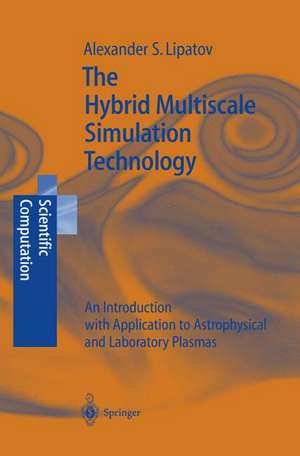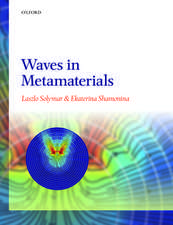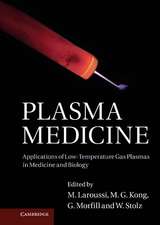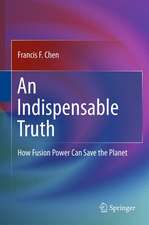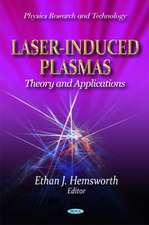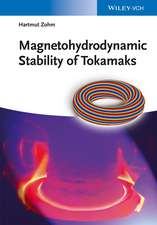The Hybrid Multiscale Simulation Technology: An Introduction with Application to Astrophysical and Laboratory Plasmas: Scientific Computation
Autor Alexander S. Lipatoven Limba Engleză Hardback – 27 mai 2002
| Toate formatele și edițiile | Preț | Express |
|---|---|---|
| Paperback (1) | 646.62 lei 6-8 săpt. | |
| Springer Berlin, Heidelberg – dec 2010 | 646.62 lei 6-8 săpt. | |
| Hardback (1) | 653.00 lei 6-8 săpt. | |
| Springer Berlin, Heidelberg – 27 mai 2002 | 653.00 lei 6-8 săpt. |
Din seria Scientific Computation
- 18%
 Preț: 1021.05 lei
Preț: 1021.05 lei - 18%
 Preț: 743.27 lei
Preț: 743.27 lei - 18%
 Preț: 889.75 lei
Preț: 889.75 lei - 18%
 Preț: 1108.51 lei
Preț: 1108.51 lei -
 Preț: 387.96 lei
Preț: 387.96 lei - 20%
 Preț: 902.00 lei
Preț: 902.00 lei -
 Preț: 400.85 lei
Preț: 400.85 lei -
 Preț: 386.61 lei
Preț: 386.61 lei - 15%
 Preț: 654.62 lei
Preț: 654.62 lei -
 Preț: 380.25 lei
Preț: 380.25 lei - 18%
 Preț: 1111.34 lei
Preț: 1111.34 lei -
 Preț: 452.62 lei
Preț: 452.62 lei -
 Preț: 389.31 lei
Preț: 389.31 lei - 18%
 Preț: 950.03 lei
Preț: 950.03 lei - 15%
 Preț: 649.22 lei
Preț: 649.22 lei - 15%
 Preț: 595.86 lei
Preț: 595.86 lei - 18%
 Preț: 942.63 lei
Preț: 942.63 lei - 15%
 Preț: 505.18 lei
Preț: 505.18 lei -
 Preț: 389.70 lei
Preț: 389.70 lei - 18%
 Preț: 957.44 lei
Preț: 957.44 lei - 15%
 Preț: 653.98 lei
Preț: 653.98 lei - 15%
 Preț: 643.99 lei
Preț: 643.99 lei - 15%
 Preț: 649.39 lei
Preț: 649.39 lei -
 Preț: 388.13 lei
Preț: 388.13 lei - 18%
 Preț: 958.38 lei
Preț: 958.38 lei - 18%
 Preț: 1129.52 lei
Preț: 1129.52 lei - 18%
 Preț: 967.56 lei
Preț: 967.56 lei - 15%
 Preț: 700.75 lei
Preț: 700.75 lei -
 Preț: 401.03 lei
Preț: 401.03 lei - 15%
 Preț: 597.99 lei
Preț: 597.99 lei -
 Preț: 385.62 lei
Preț: 385.62 lei -
 Preț: 394.87 lei
Preț: 394.87 lei -
 Preț: 385.08 lei
Preț: 385.08 lei - 18%
 Preț: 1106.63 lei
Preț: 1106.63 lei - 15%
 Preț: 504.17 lei
Preț: 504.17 lei - 15%
 Preț: 596.36 lei
Preț: 596.36 lei - 15%
 Preț: 653.98 lei
Preț: 653.98 lei
Preț: 653.00 lei
Preț vechi: 768.23 lei
-15% Nou
Puncte Express: 980
Preț estimativ în valută:
125.01€ • 130.44$ • 104.79£
125.01€ • 130.44$ • 104.79£
Carte tipărită la comandă
Livrare economică 13-27 martie
Preluare comenzi: 021 569.72.76
Specificații
ISBN-13: 9783540417347
ISBN-10: 3540417346
Pagini: 428
Ilustrații: XVIII, 403 p.
Dimensiuni: 155 x 235 x 28 mm
Greutate: 0.77 kg
Ediția:2002
Editura: Springer Berlin, Heidelberg
Colecția Springer
Seria Scientific Computation
Locul publicării:Berlin, Heidelberg, Germany
ISBN-10: 3540417346
Pagini: 428
Ilustrații: XVIII, 403 p.
Dimensiuni: 155 x 235 x 28 mm
Greutate: 0.77 kg
Ediția:2002
Editura: Springer Berlin, Heidelberg
Colecția Springer
Seria Scientific Computation
Locul publicării:Berlin, Heidelberg, Germany
Public țintă
ResearchCuprins
1 Physical Systems and Computational Models.- 2 Particle-Mesh Models.- 3 Time Integration of the Particle Motion Equations.- 4 Density and Current Assignment Force Interpolation Conservation Laws.- 5 Time Integration of the Field and Electron Pressure Equations.- 6 General Loops for Hybrid Codes Multiscale Methods.- 7 Particle Loading and Injection Boundary Conditions.- 8 Collisionless Shock Simulation.- 9 Tangential Discontinuity Simulation.- 10 Magnetic Field Reconnection Simulation.- 11 Beam Dynamics Simulation.- 12 Interaction of the Solar Wind with Astrophysical Objects.- 13 Appendix.- 14 Solutions.- References.
Recenzii
From the reviews:
"This book provides a very useful guide for researchers as well as graduate students in the field of plasma numerical modelization, primarily by hybrid methods that treat some aspects of the plasma dynamics kinematically and some others as fluids. The vast literature on the subject is summarized in a way that can rapidly be exploited by computer knowledgeable persons and a few exercises are proposed that can be used in courses in astrophysical plasmas." (Mathematical Reviews 2003g)
"This book provides a very useful guide for researchers as well as graduate students in the field of plasma numerical modelization … . The vast literature on the subject is summarized in a way that can rapidly be exploited by computer knowledgeable persons and a few exercises are proposed that can be used in courses in astrophysical plasmas. … This book, which provides a useful guide to the literature, is somewhat specialized to the specific problems of space plasmas … ." (Thierry Passot, Mathematical Reviews, 2003 g)
"This book provides a very useful guide for researchers as well as graduate students in the field of plasma numerical modelization, primarily by hybrid methods that treat some aspects of the plasma dynamics kinematically and some others as fluids. The vast literature on the subject is summarized in a way that can rapidly be exploited by computer knowledgeable persons and a few exercises are proposed that can be used in courses in astrophysical plasmas." (Mathematical Reviews 2003g)
"This book provides a very useful guide for researchers as well as graduate students in the field of plasma numerical modelization … . The vast literature on the subject is summarized in a way that can rapidly be exploited by computer knowledgeable persons and a few exercises are proposed that can be used in courses in astrophysical plasmas. … This book, which provides a useful guide to the literature, is somewhat specialized to the specific problems of space plasmas … ." (Thierry Passot, Mathematical Reviews, 2003 g)
Textul de pe ultima copertă
This book is a comprehensive description of hybrid plasma simulation models and will provide a very useful summary and guide to the vast literature on this topic. It addresses researchers and graduate students knowledgeable about computational science and numerical analysis, and can be used in courses on astrophysical and space plasmas. It is also meant for plasma installation designers. The coupled Vlasov--Maxwell equations with collisions describing well the physical system are far too heavy for numerical siumulations. Hybrid models treat some aspects kinetically and some as fluids. In the first part the author discusses hybrid codes, which include a wide spectrum of description for ions, positrons, dust grains, atoms and electrons. In the second part he treats the applications to basic plasma phenomena like particle acceleration and dissipation processes as well as to the global interaction of the solar wind with nonmagnetic planets, comets, and the local interstellar medium.
Caracteristici
There is no book so far that gives a comprehensive description of the many hybrid models used in practical applications to plasma installation and to astrophysical and space plasmas Includes supplementary material: sn.pub/extras
